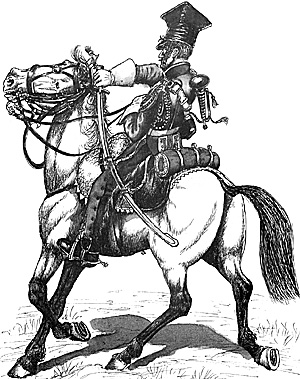 As with the infantry, the Guard cavalry fought at Marengo, but it was at Austerlitz that it delivered the first of its many famous and daring charges. The key to the battlefield of Austerlitz was the Pratzen Heights. The heights had been stormed by the Russian Imperial Guard and the struggle for this crucial ground hung in the balance.
As with the infantry, the Guard cavalry fought at Marengo, but it was at Austerlitz that it delivered the first of its many famous and daring charges. The key to the battlefield of Austerlitz was the Pratzen Heights. The heights had been stormed by the Russian Imperial Guard and the struggle for this crucial ground hung in the balance.
Trumpeter of the Dutch (Red) Lancers, campaign dress.
Against the Russian elite Napoleon sent his Guard cavalry. With four guns of the artillerie a cheval galloping ahead, two squadrons of the Chasseurs a Cheval and the Mamelukes of the Guard charged the Russian Guard and threw them back, inflicting over 500 casualties. But the Chasseurs were stopped by fresh squadrons of Russian Guard cavalry and in response Napoleon ordered the Grenadiers a Cheval to clear the heights. The charge of the Grenadiers tipped the balance, the heights were secured, and the Battle of Austerlitz all but won.
Eylau
The Guard had no part to play in the twin victories of JenaAuerstadt, but at Eylau the Grenadiers and Chasseurs a Cheval again charged to glory. At an early stage in the battle Napoleon was compelled to commit his cavalry reserve into the fray to save his weakened centre. Murat's horsemen, eighty magnificent squadrons, punched through the Russian line, reformed, and charged back through the enemy positions.
As the Russians tried to restore their shattered ranks Napoleon released his Guard cavalry to inflict further damage upon the Russians and to aid the withdrawal of Murat's now exhausted troopers. On this occasion the Grenadiers led the charge of the French cavalry. This not only relieved the pressure on Napoleon's centre but also forced a hole in the Russian line. Had the Emperor been prepared to expose his infantry of the Guard, it could have resulted in the victory that Napoleon sought.
The early months of the Peninsular War saw the cavalry of the Guard involved in two famous charges. As the French marched towards Madrid the Spaniards made a desperate attempt to halt the invaders at the Somosierra Pass. The pass was defended by 9,000 men and 16 guns behind a hastily constructed earthwork. Napoleon sent forward a division of infantry to clear the pass. However, their progress was too slow for the Emperor and he ordered his duty squadron of the 1er Regiment de Chevaux-Leger to take the pass at the gallop. Consisting of just seven officers and eighty-one men the Polish Light Horse formed up four abreast across the narrow road and charged straight towards the Spanish position. The first salvos from the Spanish guns brought the Poles to a halt but Napoleon ordered them forward again. This time they almost reached the Spanish positions before they were driven back, with only 28 men left in the saddle.
Napoleon did not repeat his mistake. The next attack was a properly co-ordinated assault. The French infantry advanced on either side of the road. The remaining two squadrons of the Chevaux-Leger, supported by the Chasseurs a Cheval, charged up the road and finally took the pass with little loss.
The other charge of the Guard cavalry in the Peninsula was a far less auspicious affair. During the pursuit of the retreating British army of Sir John Moore, the French cavalry came up against the British rearguard on the River Esla near Benavente. Opposed by what appeared to be only a weak force of British light dragoons, four squadrons of the Chasseurs a Cheval charged across the river. They charged into a trap.
Once across the river the Chasseurs formed line and advanced slowly towards the British dragoons. Twice the British charged and were repulsed, and the Chasseurs trotted on until they were two miles from the river. Then the trap was sprung. From behind Trumpeter of the Dutch (Red) Lancers, campaign dress a fold in the ground 450 men of the 10th Hussars charged the unsuspecting Chasseurs. The Chasseurs were sent reeling back towards the river leaving fifty-five dead and wounded on the field, with more being captured as they tried to re-cross the river including General Lefebvre-Desnouttes, commander of the Chasseurs. Napoleon used the Guard cavalry as a highly mobile reserve, either to support the Guard infantry and exploit any breakthrough they might have achieved, or to seize a crucial tactical objective.
At Lutzen and Bautzen in 1813 and Montmirail in 1814 the Guard ~ cheval and a pied together made the decisive attacks that won the day. At Berry in the same year the cavalry charged and captured the bridge over the River Aisne. Napoleon was always far more willing to use his Old Guard cavalry than his Old Guard infantry. At Waterloo he allowed the cavalry to be thrown prematurely against the British squares. When the infantry made its fateful attack Napoleon had no formed cavalry left to support it.
More Guard at War
Back to Age of Napoleon 18 Table of Contents
Back to Age of Napoleon List of Issues
Back to MagWeb Master List of Magazines
© Copyright 1996 by Partizan Press.
This article appears in MagWeb (Magazine Web) on the Internet World Wide Web.
Other military history articles and gaming articles are available at http://www.magweb.com